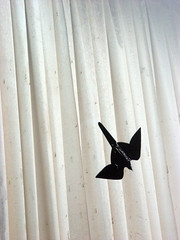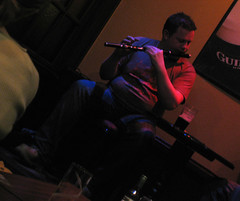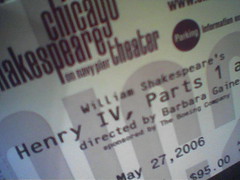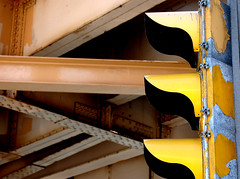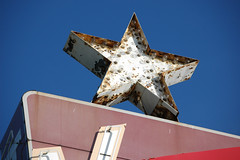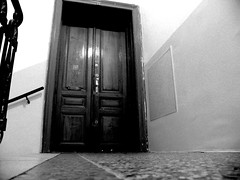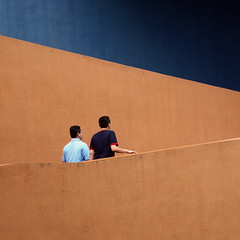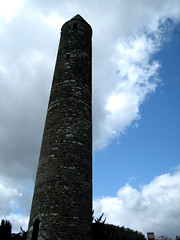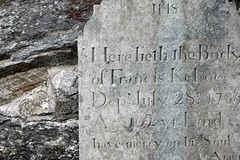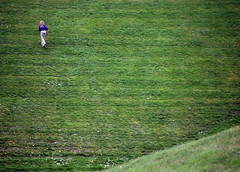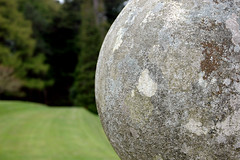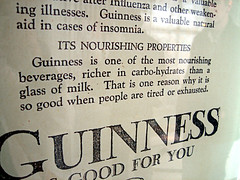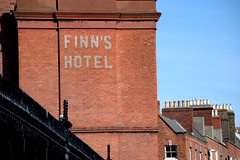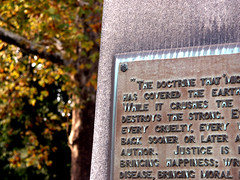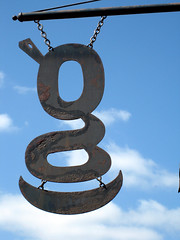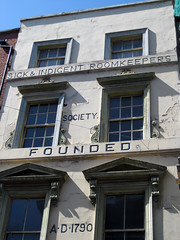Ever have one of those days when it feels like the radio is reading your mind?
Earlier tonight I was thinking about some dear friends in Seattle, the Santos, who are my extended family -– and then WBEZ here in Chicago queued up and played a track from one of Jovino’s CDs. Nice.
Then, just now, I was thinking about a writing project I want to tackle to spend some time working through my memories and grief for a dear friend recently lost. Just as I settled on a framework that I thought would work well, WBEZ did it again – they pulled out a track that TD4’s dad chose for his memorial service – a track that I don’t think I’ll ever be able to listen to again without thinking of Tom -- Shirley Horn’s Here’s to Life.
Okay. I’m listening.
Wednesday, May 31, 2006
Tuesday, May 30, 2006
whole lot of coolness
The image to the right is this site (clickthrough to watch it bloom!), as visualized as a graph by a guy in Zurich, who's also knocked together a funky mathematically driven art project that really skyrocketed today when Boing Boing got a hold of it.
Go 'head -- plug in your own URL »
Or see more funky lifeforms on Flickr »
Go 'head -- plug in your own URL »
Or see more funky lifeforms on Flickr »
the 9% solution
If the roads to love are so varied and random, how do we decide on a particular mate? It turns out that the problem of choice under uncertainty can be described and solved mathematically. Evolutionary psychologists Peter Todd at Indiana University and Geoffrey Miller at the University of New Mexico used a computer simulation to determine how a person might best choose from a number of potential partners. They set it up so that the person first assesses a number of the options available to them to decide what is the best they can aspire to in terms of attractiveness. They then go for the next person they come across who meets their aspirations, out of those they haven’t already encountered.From Sexual Attraction: The Magic Formula in the Times of London.
The researchers found that the optimum proportion of possible mates to “examine” before setting your aspirations and making your choice is a mere 9% — so at a party with 100 possible mates, it’s best to study only the first nine you randomly encounter before you choose. Examining fewer means you won’t have enough information to make a good choice, examining more makes it likely you’ll pass the best mate by. No doubt the models underestimate the complexity of real mate choice, but the fundamental insight is clear: don’t search indefinitely before choosing, lest you miss out on all the good mates or run out of time altogether.
Um...how do you know when you’ve got your initial dataset nailed down? Otherwise, how you can be sure that your subset is a true 9%? (It's not that I'm looking; it's just that I’m wondering...)
this morning's zen
I don't have to do anything special. I'm in New York. Look at me, I'm in an elevator and it's in New York. I'm in a taxi, in New York. I'm in a subway and it's in New York.William Hamb, petty officer first class, on his shore leave, as quoted in this morning's New York Times.
Yeah, I get it: It's NEW YORK. But it's also brilliantly Zen.
Monday, May 29, 2006
alan doherty
When I was in Dublin earlier this month I had the opportunity to hear a really astonishing boxwood flute player perform – on, of all things, the Musical Pub Crawl.
The back story went something like this: The pub tour is shared by a handful of local Dublin musicians who rotate the work; on the night we went a fellow named Joe Brennan (also quite good – and a brilliant wit, which made for a fun evening) was leading the tour.
By pure happenstance he bumped into his buddy, Alan O’Doherty, on the street before the gig started. Alan was visiting from Galway, where he had recently moved from Dublin, and where he’s now playing with a group called Gráda. (The name of which proved to be my undoing – but more about that in a bit.) Joe invited him along, and Alan was kind enough to sign on for the night.
What a night. His playing floored me. He gave us a good dose of traditional Celtic fare, but the thing that was most astonishing (and transporting) was the way he mixed up the Irish strains with bluegrass and jazz improvisation. Glorious good stuff. When they finally wrapped up it was far too early for my liking – I wanted to follow him home like a puppy.
We caught a flight home to Chicago the next morning so there wasn’t time to hunt out his CD in the local shops – but I figured I’d have no trouble tracking it down in the States. I was so wrong. My biggest misfire was hearing the name of his group wrong – so once I came up empty handed trying to track down “Alan O’Doherty” I started my fruitless search for a group called “Garda”. No dice.
Until today. In an offhanded conversation thread re a bumper sticker on a VW bus, debaird@flickr steered me toward Road Records in Dublin, and after a few email exchanges they straightened me out. The group’s name is Gráda, and although Road Records is presently out of their discs (but think about buying something else from them ‘cause they’re good folks), you can pick up a disc or three from Gráda’s site, and you can also download The Landing Step from iTunes, where this review will give you a glimmer of what you’re in for:
The back story went something like this: The pub tour is shared by a handful of local Dublin musicians who rotate the work; on the night we went a fellow named Joe Brennan (also quite good – and a brilliant wit, which made for a fun evening) was leading the tour.
By pure happenstance he bumped into his buddy, Alan O’Doherty, on the street before the gig started. Alan was visiting from Galway, where he had recently moved from Dublin, and where he’s now playing with a group called Gráda. (The name of which proved to be my undoing – but more about that in a bit.) Joe invited him along, and Alan was kind enough to sign on for the night.
What a night. His playing floored me. He gave us a good dose of traditional Celtic fare, but the thing that was most astonishing (and transporting) was the way he mixed up the Irish strains with bluegrass and jazz improvisation. Glorious good stuff. When they finally wrapped up it was far too early for my liking – I wanted to follow him home like a puppy.
We caught a flight home to Chicago the next morning so there wasn’t time to hunt out his CD in the local shops – but I figured I’d have no trouble tracking it down in the States. I was so wrong. My biggest misfire was hearing the name of his group wrong – so once I came up empty handed trying to track down “Alan O’Doherty” I started my fruitless search for a group called “Garda”. No dice.
Until today. In an offhanded conversation thread re a bumper sticker on a VW bus, debaird@flickr steered me toward Road Records in Dublin, and after a few email exchanges they straightened me out. The group’s name is Gráda, and although Road Records is presently out of their discs (but think about buying something else from them ‘cause they’re good folks), you can pick up a disc or three from Gráda’s site, and you can also download The Landing Step from iTunes, where this review will give you a glimmer of what you’re in for:
Gráda play with obvious respect for the ancient roots of their music, but also without any apparent fear that they might break it through experimentation. So the first thing you hear on “Tread Softly” is the cello; the melody of the original composition “Inis Dornish” sounds more Eastern European than Irish; the vocal numbers are cover versions of modern songs written by the likes of Emily Saliers and Teddy Thompson (son of Richard).Trust me. This isn’t your daddy’s Celtic music.
In short, this is an album that will be filed in the Celtic section with the trad stuff, even though it spends as much time looking to the future as to the past. Still, there's nothing quirky about the band's sound; singer Anne Marie O'Malley delivers everything with a gentle elegance, and even when the band lapses into jazzy jam band mode it never goes on long before the flute and fiddle are suddenly playing closely arranged harmonies or lilting off into another traditional reel. Most albums of Celtic music yield their charms quickly, but this one grows on you. Highly recommended.
Labels:
alan doherty,
alan o'doherty,
celtic music,
live performance,
music
Sunday, May 28, 2006
shakespeare marathon
The trouble with loving something like a play too much is that you’ve (let’s be honest here: I) have decided how the thing should play out. So it is with Henry IV.
Some folks are all over Lear, Hamlet, or those two Italian brats** – I’m just wild about Harry. Especially Part One. And after hearing on the WBEZ morning show, 848, that the conjoined production of Shakespeare’s Henry IV Parts 1 & 2, directed by Barbara Gaines, was playing to happy houses and was on its way to the UK at the invitation of the Royal Shakespeare Company, I figured the six hour investment might pay off. (And it didn’t hurt that my darlin’ companion was game – for a price, of course. But it’s barters like these that keep a marriage interesting.)
The next question that begs to be answered is: did it?
Well. Let’s get this much straight: The playwright certainly knew what he was doing.
There was a bit of a glitch with the production we saw – the regular Falstaff had fallen ill, and the understudy stepped in. It wasn’t clear from Gaines’ introduction whether or not we got the expected understudy or whether one of the other players stepped in to fill out the role. Either way, our Falstaff walked the stage with a script in hand. He was facile enough to pull it off, but it managed to break the fourth wall with repeated brutality. I supposed if it had been printed on something approximating parchment – rather than 8½ x 11 bright white printer paper with yellow highlights – maybe it would have felt more apiece.
But I’m not sure that that was what stood in the way of what, for me, is the most compelling piece of these plays. Hal was played a bit heavy and, I thought, one-dimensionally – as a bit of a dick, actually. (A very pretty dick, but very much a dick.) The piece missing was the filial love that, when played well, extends between the errant Prince and the faulty Falstaff. It’s that affection, and the alliances forged from it, that makes so poignant the gorgeous “base contagious clouds” soliloquy near the beginning of Part I, and so devastating the pentultimate scene in Part II.
None of that happened last night.
But what we lacked for poignancy and devastation, we made up for in the deft skill of a well-played play. The troupe knew what they were doing; dad Harry was brilliant; the throw-away scene in which the Welsh bride sings her goodbyes to her prince -- and is usually little more than a foil for Hotspur to get a little nookie from his sweetie before he heads off to war – had me shaking with sobs.
One last little irritation: due to the spare stage design (intended, I expect, to travel well to the UK), mist is heavily used in this production to create atmosphere and effect. Mist, of course, is wet, and the cumulative effect of sitting in the front row for 5½ hours under continual mist was not unlike encountering the well-known Chicago lake effect that brings the mean temperature down ten degrees within a certain radius of Lake Michigan.
The verdict: If Shakespeare’s language makes you ache, you won’t be disappointed in the Chicago Shakespeare Theatre’s production of Henry IV. Go – but be sure to bundle up.
**Re the Italian brats: I’m going for effect here, of course. I cared enough about Juliet’s suffering when I was in high school that I memorized her death scene for no good reason and replayed it over and over to an audience of one (me) in our unfinished basement. Of course, had I known that the duct work was carrying my death throes into my brothers’ room I might have been more discreet.
Some folks are all over Lear, Hamlet, or those two Italian brats** – I’m just wild about Harry. Especially Part One. And after hearing on the WBEZ morning show, 848, that the conjoined production of Shakespeare’s Henry IV Parts 1 & 2, directed by Barbara Gaines, was playing to happy houses and was on its way to the UK at the invitation of the Royal Shakespeare Company, I figured the six hour investment might pay off. (And it didn’t hurt that my darlin’ companion was game – for a price, of course. But it’s barters like these that keep a marriage interesting.)
The next question that begs to be answered is: did it?
Well. Let’s get this much straight: The playwright certainly knew what he was doing.
There was a bit of a glitch with the production we saw – the regular Falstaff had fallen ill, and the understudy stepped in. It wasn’t clear from Gaines’ introduction whether or not we got the expected understudy or whether one of the other players stepped in to fill out the role. Either way, our Falstaff walked the stage with a script in hand. He was facile enough to pull it off, but it managed to break the fourth wall with repeated brutality. I supposed if it had been printed on something approximating parchment – rather than 8½ x 11 bright white printer paper with yellow highlights – maybe it would have felt more apiece.
But I’m not sure that that was what stood in the way of what, for me, is the most compelling piece of these plays. Hal was played a bit heavy and, I thought, one-dimensionally – as a bit of a dick, actually. (A very pretty dick, but very much a dick.) The piece missing was the filial love that, when played well, extends between the errant Prince and the faulty Falstaff. It’s that affection, and the alliances forged from it, that makes so poignant the gorgeous “base contagious clouds” soliloquy near the beginning of Part I, and so devastating the pentultimate scene in Part II.
None of that happened last night.
But what we lacked for poignancy and devastation, we made up for in the deft skill of a well-played play. The troupe knew what they were doing; dad Harry was brilliant; the throw-away scene in which the Welsh bride sings her goodbyes to her prince -- and is usually little more than a foil for Hotspur to get a little nookie from his sweetie before he heads off to war – had me shaking with sobs.
One last little irritation: due to the spare stage design (intended, I expect, to travel well to the UK), mist is heavily used in this production to create atmosphere and effect. Mist, of course, is wet, and the cumulative effect of sitting in the front row for 5½ hours under continual mist was not unlike encountering the well-known Chicago lake effect that brings the mean temperature down ten degrees within a certain radius of Lake Michigan.
The verdict: If Shakespeare’s language makes you ache, you won’t be disappointed in the Chicago Shakespeare Theatre’s production of Henry IV. Go – but be sure to bundle up.
**Re the Italian brats: I’m going for effect here, of course. I cared enough about Juliet’s suffering when I was in high school that I memorized her death scene for no good reason and replayed it over and over to an audience of one (me) in our unfinished basement. Of course, had I known that the duct work was carrying my death throes into my brothers’ room I might have been more discreet.
Saturday, May 27, 2006
flickr images of indonesian quake
Flickrite twaooe has posted several images from this morning's earthquake in Indonesia. No notes have been included with the images, but the context is unmistakable.
Here's a link »
Here's where you can give:
Doctors without Borders (MSF) Save the Children
Here's a link »
Here's where you can give:
shake it up
I once met a seismologist who had never experienced an earthquake. He was in his mid-50s at the time.
We were at a dinner party, and this bit of information came up in the stream of conversation. As I pressed him for more information -- thinking it wonderfully ironic, and expecting he'd see some humor in it too -- he confessed that he had actually been in several small earthquakes, but had failed to feel them.
And he didn't see anything funny about it.
Cluing into his discomfort I let up on the questioning and we moved on to the next topic, but I think of this fellow periodically.
There's something mournful about his condition: A facet of his life's work is completely outside of his experience, and he can do very little to acquire that experience. You can certainly travel to earthquake prone areas -- he lived in one actually, the dinner party was in Seattle, and although that area isn't hit with the same frequency as the SF Bay Area, it's not uncommon for small tremblers to roll through on occasion -- but you can't schedule a meeting with an earthquake, or take a course. It's going to happen with or without you, and it won't be issuing invitations before the event.
But that's not so much what happened here. He was there; the earth shook; he didn't feel it.
A little like stepping out in the middle of the movie to use the restroom, and missing the one subtle scene that binds the whole film together.
[update] ah crap. about an hour after I posted this I got word of the earthquake in Central Java. at this writing the Guardian is putting the death toll at over 2,900. not the kind of synchronicity I'm keen on.
when the earth moves, she moves.
Save the Children is taking donations to help out -- I'm sure there are others as well.
We were at a dinner party, and this bit of information came up in the stream of conversation. As I pressed him for more information -- thinking it wonderfully ironic, and expecting he'd see some humor in it too -- he confessed that he had actually been in several small earthquakes, but had failed to feel them.
And he didn't see anything funny about it.
Cluing into his discomfort I let up on the questioning and we moved on to the next topic, but I think of this fellow periodically.
There's something mournful about his condition: A facet of his life's work is completely outside of his experience, and he can do very little to acquire that experience. You can certainly travel to earthquake prone areas -- he lived in one actually, the dinner party was in Seattle, and although that area isn't hit with the same frequency as the SF Bay Area, it's not uncommon for small tremblers to roll through on occasion -- but you can't schedule a meeting with an earthquake, or take a course. It's going to happen with or without you, and it won't be issuing invitations before the event.
But that's not so much what happened here. He was there; the earth shook; he didn't feel it.
A little like stepping out in the middle of the movie to use the restroom, and missing the one subtle scene that binds the whole film together.
[update] ah crap. about an hour after I posted this I got word of the earthquake in Central Java. at this writing the Guardian is putting the death toll at over 2,900. not the kind of synchronicity I'm keen on.
when the earth moves, she moves.
Save the Children is taking donations to help out -- I'm sure there are others as well.
Friday, May 26, 2006
rearview
Seems I've burned through my 15 minutes of fame this week -- first there was the mention in the trades, then Gaper's Block, a local news and event blog in Chicago, posted one of my city pics as Tuesday's Rearview pick. Now THAT I can get excited about.
Here's the link »
Here's the link »
Tuesday, May 23, 2006
givin' it up for the guthrie
 Docomomo sent an email petition around this afternoon to save the Guthrie Theatre in Minneapolis. The theatre company has moved out, and the new owner plans to tear down the Ralph Rapson structure this summer.
Docomomo sent an email petition around this afternoon to save the Guthrie Theatre in Minneapolis. The theatre company has moved out, and the new owner plans to tear down the Ralph Rapson structure this summer.If you have an interest in these things you may want to take a minute to add your name to the SAVE THE GUTHRIE petition (I’m #884), and while you’re visiting savetheguthrie.org you might want to give a read to the history of how the Guthrie came to be. It’s full of gems like these:
And if reading up on our man Guthrie makes you want to run right out and pick up a copy of his Life in the Theatre don’t bother with Amazon – it’s out of print. But Abebooks’ll do ya just fine – you might even be able to find a gently used first edition, like I did, for under $10. (And that includes shipping.) »
There was a strong sentiment among the design committee members for having Rapson plan a flexible theater that could accommodate both the classical types of production Guthrie championed and the more profitable Broadway productions that local booking agencies wished to attract.
The very idea of a house that was equipped to handle both types of productions infuriated Guthrie. He had eschewed New York in favor of Minneapolis in order to get away from the large Broadway production mentality. "He didn't want a house designed to accommodate Bob Hope's touring show. He thought an all-purpose theater was a no-purpose theater."
Guthrie argued that many of the plays he intended to mount -- ones written before the mid-seventeenth century -- had been written for the open stage. This suggested that the theater could be "considerably more flexible than might appear to the lay mind." Further, he contended, "more people can be got into the same amount of cubic space if they are seated around an open stage, rather than facing a proscenium." But this did not mean he wanted a theater-in-the-round, preferring instead to give his actors one wall against which to play.
Most important to Guthrie was the option of seating as many people as close to the action as possible, creating an intimacy that would help audiences "participate" in the production. Comfort was of secondary value. He even suggested that Rapson design the seats to tilt forward so that people would be on edge, alert. At another point, for the same reason, he proposed that the seats be little more than wooden benches.
Rapson was able to jettison both the tilted-seat and wooden-bench ideas, but he struggled more seriously with Guthrie about the spacing of rows. Rapson proposed that the distance between the seat-back in front of a viewer and that viewer's own seat-back be thirty-four inches, the prevailing standard. Guthrie balked: "How about thirty? People need to be packed together, just uncomfortable enough to pay attention." Rapson rejoined that when he and Guthrie attended performances together something Guthrie had suggested as a way of exposing the architect to different types of productions Guthrie always positioned himself on the aisle so he could stretch his legs. Guthrie grumbled but eventually agreed to thirty-two inches.
bookends
In what rates as one of the more surreal moments of my life a trade publication has taken an interest in my recent job change – enough of an interest to post the news to their home page for 24 hours, and send it out as part of a blast email campaign.
I suspect this is one of those purely speculative pieces. My former employer is a well established, privately-held cataloger and any news from an organization that doesn’t talk is, well, news – especially when it makes folks wonder WTF is going on at the company.
Had Internet Retailer called me for comment I could have given them the skinny. Matter of fact, here's my rewrite:
I suspect this is one of those purely speculative pieces. My former employer is a well established, privately-held cataloger and any news from an organization that doesn’t talk is, well, news – especially when it makes folks wonder WTF is going on at the company.
Had Internet Retailer called me for comment I could have given them the skinny. Matter of fact, here's my rewrite:
In a bid to lose the extra pounds she’s packed on since her employer relocated their offices from Chicago’s River North neighborhood to the far Northern suburb of Niles, suttonhoo (not her real name) has opted to trade in her 4 hour daily commute for a pleasant 40 minute round trip commuting to an Internet consultancy in Chicago’s Southwest suburbs.I changed jobs to tend to the bookends: To bolster those morning and evening spaces with second cups of coffee; thoughts about nothing in particular and everything at all; shared conversations and kisses -- all the little things that are required to make those bookends stand firm so that the passages they support aren't in danger of sliding off the shelf.
In the 3+ hours that she expects to gain each day she’s resolved to shoot more photos, write more stuff, and build a site or two for friends, as well as spend more time with her darlin’ companion, who was the reason she moved to the impossibly flat Chicagoland in the first place.
Sunday, May 21, 2006
flores man
A few months back I sat in on a lecture by Provost Bob Martin of the Field Museum, re the Flores Man controversy. He and his colleagues were of the opinion that the Flores Man was not a new species as some have theorized, but a human who suffered from microcephaly. He made a compelling case, and was supported by an anthropologist, also in attendance, who specialized in the tools of early man.
I found the presentation compelling, but didn't blog on it because of a subsequent conversation with a friend of mine who held the opposite opinion entirely -- and passionately -- and really knew his stuff.
I still don't feel equipped to put an opinion out there, but Martin's piece was sufficiently difficult to find online so I thought I would at least perform the public service of publishing a link to the technical comments, published this last Friday in Science »
And here's a link to a summary piece that's a little bit more accessible »
I found the presentation compelling, but didn't blog on it because of a subsequent conversation with a friend of mine who held the opposite opinion entirely -- and passionately -- and really knew his stuff.
I still don't feel equipped to put an opinion out there, but Martin's piece was sufficiently difficult to find online so I thought I would at least perform the public service of publishing a link to the technical comments, published this last Friday in Science »
And here's a link to a summary piece that's a little bit more accessible »
kamin on trump
I think it's better than anybody expected of Trump, but I don't know if that's going to be good enough.Blair Kamin, Architecture Critic for the Chicago Tribune, paraphrased in passing yesterday, when asked what he thought about the gi-normous Trump Tower under construction on the former site of the Chicago Sun Times on a prime spot alongside the Chicago River.
80,000 roses
On the 5th of May 80,000 roses were distributed by school children around Austria to commemorate the loss of 80,000 Austrian lives to Nazi genocide. Where an address was known, a rose was placed outside the door with a note.
The German-language website, A Letter to the Stars, is here »
I learned of the initiative on Flickr, where Dan65 and his wife received a rose in honor of Rosa Figdor. Her story is here »
The German-language website, A Letter to the Stars, is here »
I learned of the initiative on Flickr, where Dan65 and his wife received a rose in honor of Rosa Figdor. Her story is here »
Wednesday, May 17, 2006
warrior crafter
This is for two of my favorite crafty girls, opiliones and enyasi, from today's New York Times story about a Peruvian mummy -- a woman, a warrior, and a crafter -- dating back to 450 BCE:
A Peruvian Woman of A.D. 450 Seems to Have Had Two Careers in today's New York Times.
The most striking aspect of the discovery, archaeologists said yesterday, is not the offerings of gold and semiprecious stones, or the elaborate wrapping of her body in fine textiles, but the other grave goods.
She was surrounded by weaving materials and needles, befitting a woman, and 2 ceremonial war clubs and 28 spear throwers -- sticks that propel spears with far greater force -- items never found before in the burial of a woman of the Moche.
A Peruvian Woman of A.D. 450 Seems to Have Had Two Careers in today's New York Times.
Tuesday, May 16, 2006
feelin’ liminal
“The liminal state is characterized by ambiguity, openness, and indeterminacy. One’s sense of identity dissolves to some extent, bringing about disorientation. Liminality is a period of transition, during which your normal limits to thought, self-understanding, and behavior are relaxed, opening the way to something new.”
Wikipedia, The Free Encyclopedia
Last day at my old job today. Start a new gig tomorrow.
Wikipedia, The Free Encyclopedia
Last day at my old job today. Start a new gig tomorrow.
Saturday, May 13, 2006
saint kevin's glendalough
Tower at Glendalough, a ruined monastery south of Dublin that is the former domain of Saint Kevin -- which is a saint's name that, I'm embarrassed to admit, makes me giggle a little. I'm not sure why.
(I mean Francis or Patrick or Claire -- sure, those make sense. But Kevin? Kevin's the jock sprawled over the keg.)
Apparently he was a stubborn guy: According to the Patron Saints Index while praying during Lent with his hands outstretched a blackbird laid an egg in his palm. He kept his hand right where it was until the egg hatched.
(I mean Francis or Patrick or Claire -- sure, those make sense. But Kevin? Kevin's the jock sprawled over the keg.)
Apparently he was a stubborn guy: According to the Patron Saints Index while praying during Lent with his hands outstretched a blackbird laid an egg in his palm. He kept his hand right where it was until the egg hatched.
house
 Because the writing reminds me of West Wing when Sorkin was still around, and the main guy (Hugh Laurie) plays an insufferable crank (I have a thing for curmudgeons) who, yeah, has baby blues that you could swim for days in, and the diagnostic puzzles that bind up every episode are just so much fun -- that's why I'm loving this new show House.
Because the writing reminds me of West Wing when Sorkin was still around, and the main guy (Hugh Laurie) plays an insufferable crank (I have a thing for curmudgeons) who, yeah, has baby blues that you could swim for days in, and the diagnostic puzzles that bind up every episode are just so much fun -- that's why I'm loving this new show House.Gratefully, it managed to pick up a Peabody a little while back which helps (somewhat) mitigate that crush-striken teen feeling that's just downright embarrassing.
Friday, May 12, 2006
here lieth
Here lieth the Body of Francis Kehoe Dep. July 28th 1786 Aged 102 yr. Lord have mercy on his Soul
Amen
Grave marker at the ruined monastery of Glendalough, Ireland.
Amen
Grave marker at the ruined monastery of Glendalough, Ireland.
Thursday, May 11, 2006
hat trick
This is (only one reason) why I need my brothers -- to teach me things that I would otherwise have absolutely no clue about. Recent email thread with one of my brothers re my niece, his daughter:
bro: ...She scored a hat trick 2 weekends ago in her soccer game. They changed their names from the Pink Ponies to the Tigers this year...
me: cool beans. what's a hat trick?
bro: Three goals in one game. The other team scored four so she was a little miffed no one was helping her score goals. I pulled up Wikipedia for the origin if you're interested.
No word on whether sweet Megan got to take the ball home.
bro: ...She scored a hat trick 2 weekends ago in her soccer game. They changed their names from the Pink Ponies to the Tigers this year...
me: cool beans. what's a hat trick?
bro: Three goals in one game. The other team scored four so she was a little miffed no one was helping her score goals. I pulled up Wikipedia for the origin if you're interested.
Football (soccer)
A hat-trick occurs in football when a player scores three goals in a single game.
In most professional games the scorer of the hat-trick is allowed to return home with the match ball as a souvenir.
Some regard a "true", or "perfect" hat-trick as one where the player scores with both feet and their head in the same match (or less commonly by a header, leg shot, and penalty or free kick), though this is obviously very rare. The most common definition of a "true" hat-trick is where a player scores three goals in the same half of the match. Yet another definition, known in Germany, Belgium and Norway, is that the player scores three goals in the same net without anyone else scoring between the player's first and third goal, a "flawless" hat-trick.
Scoring two goals in the same match is also commonly known as a "brace".
No word on whether sweet Megan got to take the ball home.
the importance of place
Q. What do you value in the world above all else?
A. I value friends, family, and place.
Irish photographer Christy McNamara in the Aer Lingus inflight magazine
A. I value friends, family, and place.
Irish photographer Christy McNamara in the Aer Lingus inflight magazine
Wednesday, May 10, 2006
copyedit
From an obituary in this morning's NY Times re the French anthropologist Jacqueline Roumeguere, who married a Masai warrior:
At the time of her death, Ms. Roumeguerr-Eberhardt had just finished translating another memoir into English. Originally titled "The Six Wives of My Husband", it was amended to "The Nine Wives of My Husband" when he married three more women.
san francisco real estate, 1944
In May of 1944, just after she'd had her first child (my mother) and while her husband was at sea with the Merchant Marines, my grandmother was evicted from the apartment she was renting in San Franciso because the landlady didn't like kids. She was sharing the apartment with her girlfriend Chic, who had also just had a child, and whose husband, a recent Stanford grad, was off at basic training. They were unable to find another rental: "We got the same response every place we went. 'No children regardless of age'."
So they pooled together a $250 down payment and bought a house at 2837 Ortega Street, near 36th Avenue. According to Zillow, that house is still standing. Built in 1943, my grandmother tells me that the two-bedroom single bath at that time went for $5,250, with monthly payments of $37.02. Today Zillow values that house at $692K -- a bargain on a block of million-dollar+ homes. (And, if you're wondering: Yep. My grandparents bought out Chic's share, and then sold the house a few years later to buy their business in Mill Valley.)
Here's the Zillow link for the curious »
I pulled these details from a book that my grandmother has written for her children and grandchildren that will soon be self-published.
So they pooled together a $250 down payment and bought a house at 2837 Ortega Street, near 36th Avenue. According to Zillow, that house is still standing. Built in 1943, my grandmother tells me that the two-bedroom single bath at that time went for $5,250, with monthly payments of $37.02. Today Zillow values that house at $692K -- a bargain on a block of million-dollar+ homes. (And, if you're wondering: Yep. My grandparents bought out Chic's share, and then sold the house a few years later to buy their business in Mill Valley.)
Here's the Zillow link for the curious »
I pulled these details from a book that my grandmother has written for her children and grandchildren that will soon be self-published.
Tuesday, May 09, 2006
guinness good for you
One of the original ads for Guinness Stout reads:
Advertising, Baby. Branding pure and simple. And I paid for the privilege.
We were on the tourist circuit in Dublin, and visited every museum known to man. No where else did we queue for 20 minutes. No where else did we push through crowds like we did at the Storehouse. No where else did we lay down €28 for the privilege. No where else did we see so many smiling faces.
Did I mention the library where you could read up or listen to audio lectures on how to avoid a hangover or why beer is good for your health? It was packed.
I spend a lot of time (probably too much time -- fortunately, much of it is compensated) thinking about branding and merchandising, so the part of me that wasn't baffled tried to parse the stories, displays and exhibits to better understand why people connected so deeply and affectionately to this product.
Turns out all I really needed to do to understand it better was spend a little time in a pub with a pint of my own, good music playing, and my darlin' companion close by.
By the time I hit the bottom of that first pint it had become perfectly clear.
ITS NOURISHING PROPERTIESWe queued 20 minutes and paid €14 (per head) to visit the Guinness Storehouse – pardon me – the GUINNESS Storehouse – in Dublin where we spiraled up five stories in a slow crawl along with the rest of humanity to learn all about the manufacture, marketing and distribution of Ireland’s most famous stout – with time to spare on the tail end to grab a “free” pint and take a spin through the gift shop.
Guinness is one of the most nourishing beverages, richer in carbo-hydrates than a glass of milk. That is one reason why it is so good when people are tired or exhausted.
Advertising, Baby. Branding pure and simple. And I paid for the privilege.
We were on the tourist circuit in Dublin, and visited every museum known to man. No where else did we queue for 20 minutes. No where else did we push through crowds like we did at the Storehouse. No where else did we lay down €28 for the privilege. No where else did we see so many smiling faces.
Did I mention the library where you could read up or listen to audio lectures on how to avoid a hangover or why beer is good for your health? It was packed.
I spend a lot of time (probably too much time -- fortunately, much of it is compensated) thinking about branding and merchandising, so the part of me that wasn't baffled tried to parse the stories, displays and exhibits to better understand why people connected so deeply and affectionately to this product.
Turns out all I really needed to do to understand it better was spend a little time in a pub with a pint of my own, good music playing, and my darlin' companion close by.
By the time I hit the bottom of that first pint it had become perfectly clear.
finn's hotel
I shot this right near the spot where Nora Barnacle was walking when she was approached by James Joyce on June 10, 1904.
She had just gotten off work at Finn's Hotel, where she was employed as a chambermaid. Six days later they would meet again (and snog some), and the fateful date for Ulysses (and Bloomsday) was set: June 16th.
It should be noted that Joyce was a bit indiscriminate in his attentions: He tried the same brazen approach the following day with another young woman -- but this other gal was accompanied by a male companion who beat the tar out of Joyce. The stranger, a fellow Dubliner who happened to be a Jew, helped Joyce clean up afterwards; he would become the model for Leopold Bloom.
She had just gotten off work at Finn's Hotel, where she was employed as a chambermaid. Six days later they would meet again (and snog some), and the fateful date for Ulysses (and Bloomsday) was set: June 16th.
It should be noted that Joyce was a bit indiscriminate in his attentions: He tried the same brazen approach the following day with another young woman -- but this other gal was accompanied by a male companion who beat the tar out of Joyce. The stranger, a fellow Dubliner who happened to be a Jew, helped Joyce clean up afterwards; he would become the model for Leopold Bloom.
Monday, May 08, 2006
may day
The monument to Altgeld at Chicago's Graceland Cemetery is inscribed with statements and speeches that he made during his lifetime. Altgeld was the Governor of Illinois who pardoned the folks (those who weren't hanged) who were convicted following the Haymarket Tragedy -- as Prof. William Adelman called it in a lecture that I caught this last Sunday.
The folks who were there at the Haymarket were advocating for the eight hour day or, more concisely: "Eight hours for work; eight hours for sleep; and eight hours for what we will."
One of the individuals pardoned many years later by Altgeld had been convicted to 15 years of hard labor in Joliet for donating $2 toward the purchase of the printing press that was used to print the flyers advertising the event. He was not present at the Haymarket that night. The fellow who actually printed the flyers was hanged. He wasn't there either.
This side of Altgeld's monument reads:
Around here we don't talk about it much at all.
The folks who were there at the Haymarket were advocating for the eight hour day or, more concisely: "Eight hours for work; eight hours for sleep; and eight hours for what we will."
One of the individuals pardoned many years later by Altgeld had been convicted to 15 years of hard labor in Joliet for donating $2 toward the purchase of the printing press that was used to print the flyers advertising the event. He was not present at the Haymarket that night. The fellow who actually printed the flyers was hanged. He wasn't there either.
This side of Altgeld's monument reads:
The doctrine that 'might makes right' has covered the earth with misery. While it crushes the weak, it also destroys the strong. Every deception, every cruelty, everyEvery industrialized nation in the world, with the exception of the US and Canada, celebrate May 1st as Labor Day. In Mexico they call it the Day of the Chicago Martyrs.
wrong, reaches back sooner or later and crushes its author. Justice is moral health, bringing happiness; wrong is moral disease bringing moral death.
Around here we don't talk about it much at all.
Saturday, May 06, 2006
architecture in the city
Kicked off a four-week course this morning with Blair Kamin, the architecture critic for the Chicago Tribune. First stop: Millennium Park (is it possible to get tired of that big, beautiful Bean?), followed by the Glessner House at 1800 Prairie Ave South.
Seeing the Glessner was interesting in the wake of the Ireland trip. Designed by Henry Hobson Richardson between 1885 and 1887 for the Scottsman Glessner, it’s a lovely merger of Scotts practicality and the Arts & Crafts movement, both inside and out (a couple of rooms are festooned in Morris-patterned wallpaper -- an unexpected treat). There's also a sweet hint of neo-celtic motifs bubbling through -- the house is a contemporary with W.B. Yeats after all, and with the Irish nationalism that was finding its voice around that time. (Ask me if I would even have noticed that if I hadn't just returned from Dublin.) One obvious example: A Celtic Tree of Life symbol decorates the archway over the front door.
The structure itself is particularly cool because it’s clearly granddaddy to so many of the great ideas that Sullivan and Wright will soon express in their architecture. I’d call the arch over the front door Sullivanesque if it didn’t pre-date Louis – maybe it’s more accurate to say that Sullivan’s arches are Richardson-esque. And he also played a little trick with the street – bricking it off to buffer the family from the mess and the noise – something FLW will be all about once he gets rolling in his work.
Another piece of random trivia that made me happy: Richardson was good buddies with Frederick Law Olmsted, the designer of Central Park in NYC and the UC at Berkeley campus. (I'm a big fan.)
Of course, next Saturday, if the sun is shining like it was today, I’ll be certain to bring the sunscreen and turn periodically like a steak on the grill so I don’t come away with only one half of my face sunburned, like I did today. (Yeah, if you're wondering, I do look like an idiot.)
Seeing the Glessner was interesting in the wake of the Ireland trip. Designed by Henry Hobson Richardson between 1885 and 1887 for the Scottsman Glessner, it’s a lovely merger of Scotts practicality and the Arts & Crafts movement, both inside and out (a couple of rooms are festooned in Morris-patterned wallpaper -- an unexpected treat). There's also a sweet hint of neo-celtic motifs bubbling through -- the house is a contemporary with W.B. Yeats after all, and with the Irish nationalism that was finding its voice around that time. (Ask me if I would even have noticed that if I hadn't just returned from Dublin.) One obvious example: A Celtic Tree of Life symbol decorates the archway over the front door.
The structure itself is particularly cool because it’s clearly granddaddy to so many of the great ideas that Sullivan and Wright will soon express in their architecture. I’d call the arch over the front door Sullivanesque if it didn’t pre-date Louis – maybe it’s more accurate to say that Sullivan’s arches are Richardson-esque. And he also played a little trick with the street – bricking it off to buffer the family from the mess and the noise – something FLW will be all about once he gets rolling in his work.
Another piece of random trivia that made me happy: Richardson was good buddies with Frederick Law Olmsted, the designer of Central Park in NYC and the UC at Berkeley campus. (I'm a big fan.)
Of course, next Saturday, if the sun is shining like it was today, I’ll be certain to bring the sunscreen and turn periodically like a steak on the grill so I don’t come away with only one half of my face sunburned, like I did today. (Yeah, if you're wondering, I do look like an idiot.)
John J. Glessner House
1800 S. Prairie Ave
Chicago, IL
1885-1887, Henry Hobson Richardson
stardust memories
The Stardust in Las Vegas, which opened in 1958, is scheduled for demolition next Spring. The Desert Inn, a veteran from 1950 on the Vegas strip, came down in 2001. The Boardwalk (1964) will be dust and rubble tomorrow.
So it sounds like Vegas is going the way of the cheap ballgame -- another pastime that, at $50+ a seat, is no longer within reach of folks like my Grandpa Schufman who attended the Yankees/Dodgers World Series with religious fervor (when the Dodgers were still in Brooklyn) and logged every hit, ball, strike and foul. (You'll have to ask my brother which series -- and whether it was in the 40s or the 50s -- he's the one with the scorecard and ticket stubs framed behind glass hanging over his desk.)
Are we really so swank as a general population that we can afford nothing but posh when it's time to blow off a little steam?
Las Vegas "was known as the capital of cheap rooms and cheap food," said Alan Feldman, a spokesman for MGM Mirage, the giant hotel and casino company developing the Boardwalk site. "It was known as the capital of the cheap vacation -- and you got what you paid for. We used to give coupons books for free drinks and two-for-one buffet. Now we have 300-thread-count sheets and turn-down service."Vegas isn't my playground -- I play my poker at home with folks I know because the tell is all and I'm lame at figuring out strangers -- but cheap vacations for Middle America matter to me. My grandparents were married in Reno, on a day-trip out of San Francisco, where they returned after an afternoon at the slots to conceive my mother, and then six more kids over time. And Reno was the place they returned, when they had a minute between raising their brood in Sonoma and running their business out of Mill Valley -- all geographies that are far out of reach of folks with moderate incomes anymore.
From No More Cheap Shrimp Cocktail in this morning's New York Times
So it sounds like Vegas is going the way of the cheap ballgame -- another pastime that, at $50+ a seat, is no longer within reach of folks like my Grandpa Schufman who attended the Yankees/Dodgers World Series with religious fervor (when the Dodgers were still in Brooklyn) and logged every hit, ball, strike and foul. (You'll have to ask my brother which series -- and whether it was in the 40s or the 50s -- he's the one with the scorecard and ticket stubs framed behind glass hanging over his desk.)
Are we really so swank as a general population that we can afford nothing but posh when it's time to blow off a little steam?
"They're pushing out the more moderate-income person," Mrs. Aynseworth, [a retiree from Torrance, Calif],
said. "Aren't they the people who helped build Las Vegas?"
NYT
Friday, May 05, 2006
like currents through my head
I haven’t traveled to Italy, but I’m told by friends who have that they love the wide open passionate love of life expressed by the Italians they’ve met and observed on their travels. The being unafraid to say it out loud -- and loudly -– to care and ache and weep and love.
Having just returned from Dublin I feel an appreciation a little bit like that for the bald love that I saw there for language and music and melody. As an American I love these things in secret; I finger them in private; I share my love with a few friends and when we’re together our conversation shifts in pitch like initiates sharing a secret handshake. In America to be too fond of words is to be a little too precious, a little effete -- and we’re nothing if NOT that here in America, goddammit.
So here’s a treasure, from the poetry of Brendan Kennelly, found this last week while traveling in the lovely Éire. Here is what I’m fingering now in the quiet of my room at night.
Having just returned from Dublin I feel an appreciation a little bit like that for the bald love that I saw there for language and music and melody. As an American I love these things in secret; I finger them in private; I share my love with a few friends and when we’re together our conversation shifts in pitch like initiates sharing a secret handshake. In America to be too fond of words is to be a little too precious, a little effete -- and we’re nothing if NOT that here in America, goddammit.
So here’s a treasure, from the poetry of Brendan Kennelly, found this last week while traveling in the lovely Éire. Here is what I’m fingering now in the quiet of my room at night.
bridge
and in the dark to lean across
like a bridge over a river on whose bed
stones are untroubled by what passes
overhead
and kiss the sleep in your body
with I love you I love you
like currents through my head
that is closer to deep water now
than at any time of the day
Brendan Kennelly
A Time for Voices: Selected Poems 1960-1990
Thursday, May 04, 2006
in the company of roomkeepers
The lettering on this building, just outside the gates to Dublin Castle, reads "Sick & Indigent Roomkeepers Society. Founded A.D. 1790"
As to what kind of society sick and indigent roomkeepers kept, your guess is as good as mine.
(Although I suspect it was folks like these who were responsible for the sick and indigent part »)
As to what kind of society sick and indigent roomkeepers kept, your guess is as good as mine.
(Although I suspect it was folks like these who were responsible for the sick and indigent part »)
the still point of detachment
Flying home to Chicago out of Dublin yesterday, I finally sat down with the book I meant to read before the trip -- How the Irish Saved Western Civilization -- and hit on this passage, a reference to the Celts and the color of their world prior to St. Patrick’s reshaping of it. It captures beautifully that sense of something lost –- the faint memory that hangs around Irish literature and history and music (or seems to, to an outsider like me) –- like that feeling you get when you’re napping in the soft breeze of an open window and your friend’s voice calls to you from the street below; but before you can shake off the sleep and respond, he’s gone.
Fixity escaped these people, as in the end it escapes us all. They understood, as few have understood before or since, how fleeting life is and how pointless to try to hold on to things or people.
They pursued the wondrous deed, the heroic gesture: fighting, fucking, drinking, art –- poetry for intense emotion, the music that accompanied the heroic drinking with which each day ended, bewitching ornament for one’s person and possessions.
All these are worth pursuit, and the first, especially, will bring the honor great souls seek. But in the midst of this furious swirl of energy lies a still point of detachment. When in the heat of battle, the bloodied messenger informs Medb timidly that Chuchulainn has beheaded her son, she responds, “This isn’t like catching birds,” as we might say, “you didn’t think this would be a picnic, did you?”
The face of the Dying Gaul speaks for them all: each one of us will die, naked and alone, on some battlefield not of our own choosing. My promise of undying faithfulness to you and yours to me, though made with all solemnity, is unlikely to survive the tricks that fate has in store – all the hidden land mines that beset human life. What we can rely on are the comeliness and iron virtue of the short-lived hero: his loyalty to cause and comrades, his bravery in the face of overwhelming odds, the gargantuan generosity with which he scatters his possessions and his person and with which he spills his blood.
After the assassination of John F. Kennedy, Daniel Patrick Moynihan was heard to say that to be Irish is to know that in the end the world will break your heart.
Thomas Cahill in How the Irish Saved Western Civilization: The Untold Story of Ireland's Heroic Role from the Fall of Rome to the Rise of Medieval Europe
dinner in dublin
On the cab ride into Dublin I asked the driver if he could recommend any good places to eat, and he suggested that we check out any one of many Chinese restaurants to have recently sprouted up around town.
Not what I expected to hear, driving into Dublin for the first time ever.
Turns out the rate of immigration from China to Ireland in the last three or four years has been sizeable.
Having spent plenty of time devouring asian cuisine I should have known better than to order the steamed seabass in a ginger and blackbean sauce. Of course the bass would come fully intact. But of course, once I got past my aversion to seeing my dinner staring up at me, it would be delicious.
Not what I expected to hear, driving into Dublin for the first time ever.
Turns out the rate of immigration from China to Ireland in the last three or four years has been sizeable.
Having spent plenty of time devouring asian cuisine I should have known better than to order the steamed seabass in a ginger and blackbean sauce. Of course the bass would come fully intact. But of course, once I got past my aversion to seeing my dinner staring up at me, it would be delicious.
Subscribe to:
Posts (Atom)
